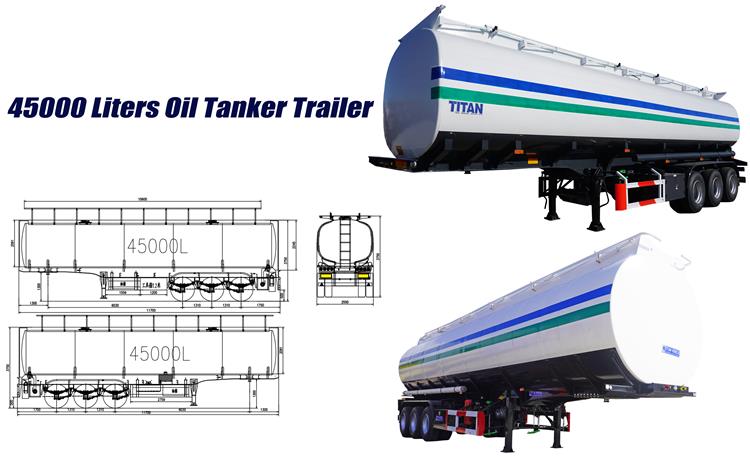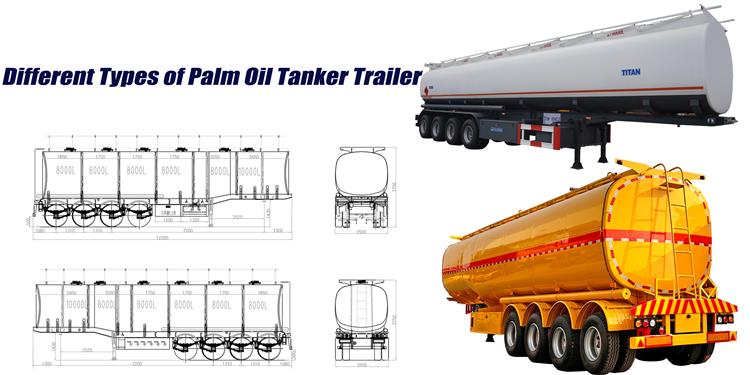The Main Specification of Oil Tanker Semi Trailer
How Many Litres is an Oil Tanker Trailer?
How to Choose a Suitable Oil Tanker Trailer?
How to Load and Unload Oil in Oil Tanker Truck?
Tank body: The tank body is the main part of the oil tanker trailer for sale, usually made of steel or aluminum alloy, and coated with anti-corrosion coating inside to avoid corrosion of the tank body by oil.
Shaft set: palm oil tanker price usually adopts double or triple shaft design to increase load capacity and stability. The axle group usually adopts an air suspension system to reduce bumps and improve driving comfort.
Braking system: Crude oil tanker trailers are usually equipped with a hydraulic braking system, including brake discs, brake drums, brake pads, brake fluid, etc.
Site: The site of an oil tanker price is usually made of steel to enhance the structural strength and load-bearing capacity of the entire body.
Suspension system: The suspension system of oil tanker cost usually adopts airbag suspension or leaf spring suspension to reduce bumps and improve driving comfort.
Tires: The tires of oil tanker cost usually use high-strength steel wire tires or nylon tires to improve load-bearing capacity and durability.
Lighting system: The oil tanker truck is equipped with front and rear lights, turn signals, brake lights, etc. to ensure driving safety.
Tail: Withstand 10T impact modular rear bumper, ultra-high safety performance to protect the tank from damage
 Oil Tanker Trailer | How Many Litres is a Tanker Trailer
Oil Tanker Trailer | How Many Litres is a Tanker Trailer
Valve: ADR standard valve, widely used in major oil companies, high quality ensures longer service life.
Cables and Pipes: Cable and pipe routing and clamping systems allow direct and easier access during diagnostic testing and replacement
Oil outlet valve: The oil tanker trailer for sale has a special design for the oil outlet valve, which can better ensure that we will not leak oil when we disassemble the joint. The internal structure is more in line with hydrodynamics, which can balance the internal pressure when there is a large amount of cargo flowing out.
Anti-overflow sensor: When liquid fuel is loaded, we cannot detect how much is being added at every moment, then we need to use anti-overflow sensor, when it reaches the specified height, it will send an alarm.
Safety valve: An important part of the oil tanker semi trailer is the safety valve. The valve is used to automatically adjust the pressure in the tank to ensure the safety of the palm oil tanker price tank and reduce the volatilization of oil.
Seabed valve: The seabed valve is usually installed at the bottom of the oil tanker cost oil tank. Usually, its function is to prevent the leakage of the transported liquid fuel after an accident in the oil tanker trailer for sale, causing greater economic losses. In the event of an accident, the seabed The valve will automatically cut off the pipeline within 3 seconds to ensure the safety of the transported goods.
Manhole cover: The manhole cover is specially designed, and it has many functions, which can ensure the safety of the oil tanker semi trailer to a certain extent
The capacity of an Oil tanker trailer for sale may vary depending on its size and type. Palm oil tankers can be used to transport various types of liquids, including water, fuel, chemicals, and food. The capacity of a tanker trailer is usually measured in cubic meters or liters.
It's important to note that the actual capacity of an oil tanker semi trailer depends on a variety of factors, including its size, shape, and material of manufacture. Also, the capacity of the oil tanker trailer for sale may be subject to local laws and regulations, so be sure to check with your local government to ensure compliance.
The capacity of a Palm oil tanker price can vary greatly depending on its design and purpose. However, the common size of a crude oil tanker trailer used to transport liquid cargo such as fuel or chemicals is around 40,000 to 45,000 litres.
A typical crude oil tanker trailer has a capacity of about 20,000 to 90,000 liters. The exact capacity depends on the size and design of the oil tanker price, but this is a fairly standard range for oil tanker costs. Some common sizes are:
 Oil Tanker Trailer | How Many Litres is a Tanker Trailer
Oil Tanker Trailer | How Many Litres is a Tanker Trailer
Some key facts about typical oil tanker truck dimensions:
Small tankers: approximately 9,000 to 12,000 litres. It is often used to transport food-grade products, lubricating oil, etc.
Medium tankers: 12,000 to 18,000 litres. Widely used in chemicals, petroleum products and other products.
Large tank trucks: over 18,000 liters. Usually used to transport large volumes of petroleum products, chemicals, vegetable oils, etc. Some large tankers can hold 90,000 litres.
Super mono tankers: some trailers use a single rear axle with wide super mono tires, which can increase capacity to around 24,000 to 30,000 litres. But these are more expensive and less common.
Insulated tanker: For temperature sensitive products, use an insulated tanker with thicker wall thickness and insulation. Insulated tankers usually hold slightly less volume due to the extra thickness of the tank.
So all in all, a typical small to medium tanker trailer holds between 9,000 and 18,000 liters. Larger tankers can hold up to 30,000 liters - 90,000 liters and are the most commonly sold oil tanker semi trailer.
 Oil Tanker Trailer | How Many Litres is a Tanker Trailer
Oil Tanker Trailer | How Many Litres is a Tanker Trailer
The oil tanker trailer for sale is a semi-trailer with a tank-type structure for the loading part. It is mainly used to transport liquids, bulk materials and bulk cement, etc. The oil tanker semi trailer has a stronger load capacity.
Generally speaking, the price of palm oil tanker is not fixed and uniform, and its price varies according to many parameters, including the number of tires, load capacity, front overhang radius, payload, wheelbase, speed, external dimensions, etc. In addition, the manufacturer of crude oil tanker trailer will also affect its price. There is no fixed price for this price. Different manufacturers and different performances will have different prices. You should consult the manufacturer for the specific price.
Choosing an oil tanker price that suits your needs requires consideration of many factors. Here are some hints that might help:
Requirements: Including what kind of goods to pull mainly, what is the weight of the goods to be pulled, and the roads that are often taken. Don’t blindly follow the crowd, but follow your own requirements and future judgments. Different types of oil tanker trucks are suitable for transporting different kinds of liquids, such as gasoline, diesel, liquid chemicals and so on. When choosing an oil tanker trailer for sale, you need to make sure it is suitable for the cargo you are transporting.
Capacity and size: The capacity and size of the oil tanker semi trailer need to be selected according to your transportation needs. If you need to transport a lot of liquid, then you need to choose a palm oil tanker price with a larger capacity. Also, consider whether the crude oil tanker trailer is the right size for your transportation needs to ensure it can travel on the road.
Material and Quality: The material and quality of the oil tanker price are also important. Generally speaking, the material of the oil tanker cost should be corrosion-resistant, high-temperature-resistant, pressure-resistant, and have good sealing performance. In addition, the quality of the oil tanker truck also needs to meet the relevant national standards to ensure safe transportation.
Vehicle configuration: The vehicle configuration of the oil tanker trailer for sale also needs to be considered. It mainly depends on the weight, bearing capacity, traction force, overall size, speed, etc. of the oil tanker semi trailer. A semi-trailer with good performance can improve the efficiency of cargo transportation. Whether it needs to have a self-unloading function, whether it needs to have a heating device, etc.
Manufacturer and after-sales service: Choosing a reputable and experienced palm oil tanker price manufacturer can ensure that you buy a product of reliable quality, and can provide timely after-sales service and repair support. Whether the after-sales service can be achieved requires the car manufacturer to be very mature in the after-sales service, and needs to be able to deal with the after-sales problems of vehicles in a timely manner and solve the worries of users.
Choosing a crude oil tanker trailer requires comprehensive consideration of many factors to ensure that you are buying a high-quality product that meets your needs
Oil tanker trailer for sale is a special vehicle used to transport liquid goods (such as oil, chemicals, etc.). The process of loading and unloading oil needs to follow certain safety regulations to ensure the safety of operators and the environment. The following are the basic steps for loading and unloading oil:
Oil Tanker Trailer Loading Oil
Safety check: Before loading oil, make sure the oil tanker semi trailer is in the correct position and parked stably. At the same time, check whether the tires, brakes, lights and other equipment of the oil tanker trailer are in good condition, and whether the oil tank and pipeline are leaking.
Grounding: Ground the palm oil tanker price to the filling station to prevent static sparks from starting a fire.
Connect the oil pipeline: connect the oil pipeline of the oil loading station to the crude oil tanker trailer, and ensure that the connection is well sealed to prevent oil spillage.
Open the valve: Under the supervision of the operator, open the valve of the oil pipeline and start injecting oil into the oil tanker price. Please note that relevant regulations must be followed during the filling process, such as not exceeding the maximum capacity of the oil tank.
Close the valve and oil pipeline: After the oil tanker cost is full, close the valve and oil pipeline to ensure that the oil in the oil tanker trailer for sale and the oil pipeline has stopped flowing.
Disconnect: Disconnect the fuel line from the tanker semi-trailer and check the connection for oil spillage.
Oil Tanker Semi Trailer Unloading Oil
Safety check: Before unloading oil, the oil tanker trailer is parked stably in the oil unloading area. At the same time, check whether the tires, brakes, lights and other equipment of the vehicle are in good condition, and whether there are leaks in the oil tank and pipeline.
Grounding: Ground the oil tanker semi trailer to the unloading station to prevent static sparks from starting a fire.
Connect the oil pipeline: connect the oil pipeline of the oil unloading station to the tank semi-trailer, and ensure that the connection is well sealed to prevent oil spillage.
Open the valve: Under the supervision of the operator, open the valve of the crude oil tanker trailer to start unloading the oil from the oil tank into the oil storage facility at the oil unloading station. Please note that relevant regulations must be followed during the unloading process, such as not exceeding the maximum capacity of the unloading station.
Close valves and lines: After the tank is empty, close the valves and lines to ensure that the oil in the tank and lines has stopped flowing.
Disconnect: Disconnect the oil pipe from the oil tanker cost and check the connection for oil spillage.
During the whole process of loading and unloading oil, safety is the first element. Operators should always follow safety procedures and wear appropriate protective equipment such as hard hats, safety glasses, non-slip gloves, etc. when required. At the same time, ensure that the site is well-ventilated.